Denial of Peter


The denial of Peter denotes the three-time denial of Jesus by the apostle Peter reported in all four canonical Gospels of the New Testament . This topic was later u. a. taken up in early oratorios and in the fine arts, for example by the Italian painter Caravaggio in his oil painting Negazione di San Pietro, completed in 1610 .
Biblical representations
In the Passion story, the Gospels tell that Jesus, when he was about to be arrested, predicted during the Last Supper or on the way to the Mount of Olives that his trusted disciple Peter would deny him three times that same night before the cock crows. Peter denied this and instead assured him that he would remain faithful to his Lord on his path of suffering and, if necessary, even want to die for him ( Mk 14.27-31 EU ; Matt 26.31-35 EU ; Lk 22.31-34 EU ; Joh 13.36-38 EU ). In two verses preceding the denial, Luke explains that Jesus first told Peter that all disciples were endangered by Satan , but that he prayed that Peter's faith would not cease; and when Peter has been converted again, he should strengthen his brothers (Lk 22: 31f.).
To prevent Jesus from being captured, according to John 18:10, Peter is said to have taken up his sword and cut off an ear from Malchus, who was a servant of the high priest. This scene of the ear being severed is also par. In Mk 14.47. reported, but the name of the responsible three-bat is not given. Jesus disapproved of this violent approach (Mt 26:52; Lk 22:51; Jn 18:11). Like all the other disciples, Peter then fled (Mt. 26,56 par.).
When Jesus was led away, Peter followed him “from afar” to the court of the high priest. According to Joh 18.15f. Peter was doing in the company of another, known to the high priest disciples, he by its placement in the courtyard of Annas went in. He sat down with the servants by the fire to warm himself, but was recognized as a Galilean by his language and a maid accused him of being a follower of Jesus, which Peter denied. Apparently he had overestimated his power of faith and failed at the first test to demonstrate his loyalty to his master. He denied this two more times. The rooster immediately crowed, reminding Peter of Jesus' prophecy. He then wept and thereby expressed his deep repentance ( Mk 14.66–72 EU ; Mt 26.69–75 EU ; Lk 22.56–62 EU ; Joh 18.15–18 EU and Joh 18.25–27 EU ). Luke relieves Peter somewhat compared to the presentation in the Gospel of Mark in that he does not allow him to use any formulas for oaths when denying them (Lk 22.60 versus Mk 14.71). Luke also mentions, as the only evangelist, that after the third denial by Peter, Jesus turned to him and gave him a remembering look (Lk 22:61).
That the denial of Jesus by Peter was essentially a historical event, take u. a. Otto Böcher and Lothar Wehr . The opposite view, advocated by some researchers, that the historicity of this episode is doubtful, could not prevail.
According to Otto Böcher, this failure of the most important apostle of Jesus Christ alongside Paul still aroused such offense in early Christianity decades later that it had to be processed theologically, for example, when the Gospel of John Peter was called three times by the risen Jesus to pasture his sheep (Joh 21.15-17).
literature
- Erich Fascher : Petrus 121. In: Paulys Realencyclopädie der classischen Antiquity Science (RE). Volume XIX, 2, Stuttgart 1938, column 1340 f.
- Otto Böcher : Petrus I , in: Theologische Realenzyklopädie (TRE), Vol. 26 (1996), p. 264; 266; 269.
Web links
Remarks
- ↑ a b Otto Böcher: Petrus I , in: Theologische Realenzyklopädie (TRE), Vol. 26 (1996), p. 269.
- Jump up ↑ Lothar Wehr: Petrus, Apostel , in: Lexikon für Theologie und Kirche (LThK), 3rd edition, Vol. 8 (1999), Col. 91.
- ^ E.g. E. Linnemann, Studien zur Passionsgeschichte , 1970, p. 85.
- ↑ Michael Wolter : Petrus I (Gestalt) , in: Reallexikon für Antike und Christianentum , Vol. 27 (2016), Col. 390.